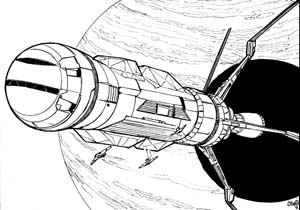Scout (JumpShip class)
Sarna News

- HEXTECH Review - Wave 3 Brings More Urban Options To Your Battlefield
- Your BattleTech News Round-Up For March, 2024
- Crashing 'Mechs With Jennifer Brozek, Author Of The Rogue Academy Trilogy
- Getting The Word Out With Rem Alternis, Catalyst Community & Marketing Director
- Bad 'Mechs - Yeoman
- Read more →
| 191px | |
| Scout Class JumpShip | |
|---|---|
| Production information | |
| Manufacturer | *Irian Technologies, |
| Use | Exploration/Military |
| Tech Base | Star League |
| Cost | 300,000,000 C-Bills |
| Introduced | 2712 |
| Technical specifications | |
| Mass | between 75,000 and 90,000 tons |
| Length | 273 meters |
| Sail Diameter | |
| Fuel | |
| Burn Rate | |
| Top Thrust | 0.2 Gs |
| Sail Integrity | |
| KF Drive Integrity | |
| LF Battery | None |
| Armament | None |
| Armor | 40 tons |
| DropShip Capacity | 1 |
| Crew | 17 crew, 1 AeroSpace Pilot |
| Grav Decks | None |
| Escape Pods/Life Boats | None |
| Heat Sinks | 0 + 121 |
| Structural Integrity | |
| BV (1.0) | ??? |
Description
The Scout class is the smallest JumpShip class still in common use. Its small carrying capacity (only one DropShip) means that it is primarily used for military operations or exploration - the maintenance costs are too prohibitive for it to be viable commercially. It does, however, possess up-to-date medical and recreation facilities and the bridge is quite modern by comparison to larger class vessels.
There are several benefits to the Scout design. The first is its tiny emergence signature which is difficult to detect, making the ship ideal for reconnaissance and surprise raids. The second is that it takes only 80% of the normal time required to quick-charge a Scout over an average-sized JumpShip. The third is that the docking collar is reinforced, allowing the Scout to thrust at 0.1 Gs acceleration even with a DropShip attached, provided that the DropShip is less than 25,000 tons in mass; without a DropShip, the Scout can accelerate at 0.2 Gs. And the fourth is that the Jump Sail (which requires only 90% of the time to unfurl/furl compared to a larger sail) is less susceptible to rips and other forms of damage.
Armament
These vessels do not, by default, possess any weapons. There is a small craft bay, however, that can support Small Craft of up to 150 tons, and it is likely that a Scout will have a single AeroSpace Fighter to ward off attackers.
Cargo
Depending on the exact variant and subtype, the Scout can carry up to 450 tons of cargo in the cargo section. Other sources suggest it typically carries 900 tons of spare parts and has 116.5 tons of regular cargo space.
Variants
Numerous minor variations of the standard Scout class are known. Different sources suggest a different mass for the Scout class, ranging from 75,000 tons (AeroTech rulebook) through 79,000 tons (most other sources) up to 90,000 ton (Technical Readout 3057); these might well be different variants.
The capabilities of the Scout changed over time (due to changes in the construction rules for JumpShips, and slight differences in various sources) which could be assumed to represent different subvariants; some or all of there restrictions may or may not be associated with the aforementioned 75,000, 79,000 or 90,000 ton versions or apply to any individual Scout class ship:
- Some descriptions claim its Hardpoint cannot dock DropShips massing more than 25,000 tons. (A point that is not supported by rules.)
- One source [Page Reference?] claims that DropShips require one Hardpoint for every 60,000 tons of mass, which means by extension that very large DropShips are not allowed to dock with the Scout as it has only a single Hardpoint. (This was a BattleSpace ruling that has been superseded implicitly by Aerotech 2nd Edition, and finally explicitly codified in Tech Manual.)
- Finally, it has been reported that the Scout cannot use its maneuvering thrusters when docked with a DropShip exceeding 25,000 tons in mass. (Another point not represented in any rules.)
(In a similar fashion, there are no game rules for the other advantages associated with the Scout class, namely faster quick-charging and reduced sail deployment time.)
Quetzalcoatl
Quetzalcoatl-Scout-class: One notable variant of the Scout class is a refit that was first made the Third Succession War era. The refit converts the cargo space and Docking collar/Hardpoint into 12 fighter cubicles, thereby enabling the ship to act as a fighter support carrier at the cost of its DropShip carrying capability. Operating the fighters in shifts has allowed such ships to maintain a fighter force of up to 20.
The first ship to undergo such a refit was the Capellan Confederation's Quetzalcoatl, after it suffered crippling damage to its Hardpoint in an enemy boarding attempt. Although the original Quetzalcoatl was destroyed in the Fourth Succession War, the refit proved successful and several other ships have been refitted in this way. They are colloquially known as the Quetzalcoatl-Scout-class.
References
- DropShips and JumpShips - pp 16-17
- Technical Readout 3057 - pp 94-95
- BattleSpace rulebook - p. 51
- Mercenary's Handbook 3055 - p. 23
- AeroTech rulebook - p. 60


